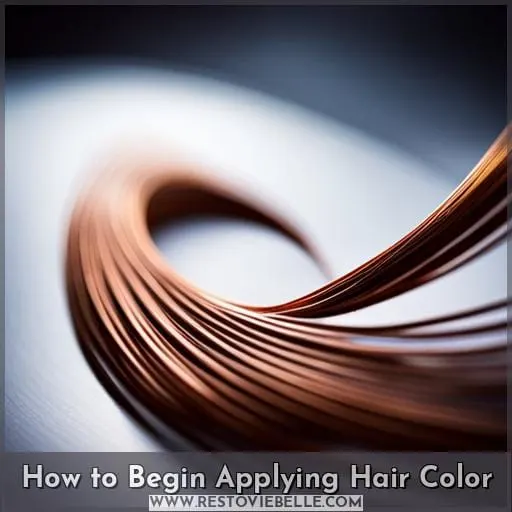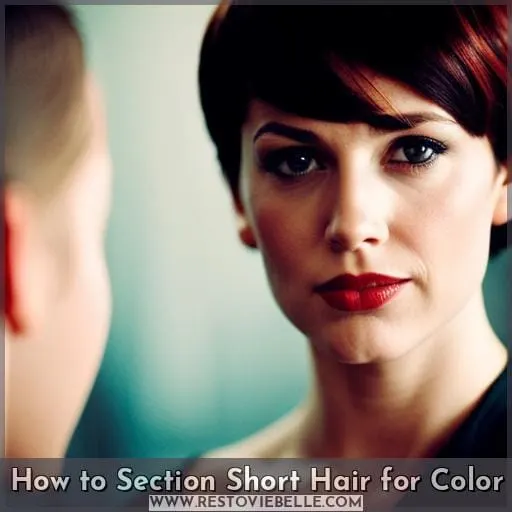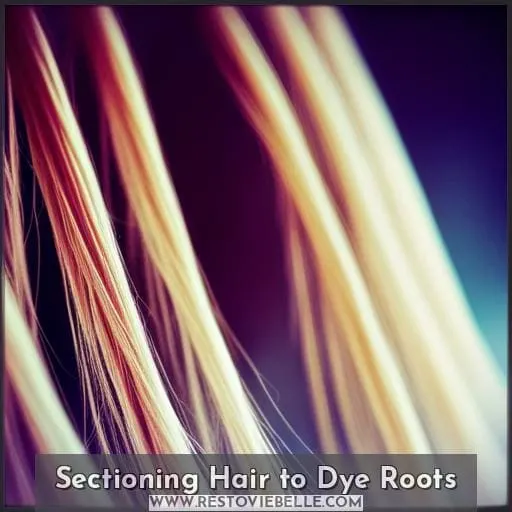This site is supported by our readers. We may earn a commission, at no cost to you, if you purchase through links.
 Are you looking to dye your own hair but don’t know where to start? Sectioning your hair before coloring is an important step in the process, and it’s easier than you think. If you’re unsure of how to go about sectioning your mane correctly for dyeing, we have a few tips that will make sure every strand looks perfect.
Are you looking to dye your own hair but don’t know where to start? Sectioning your hair before coloring is an important step in the process, and it’s easier than you think. If you’re unsure of how to go about sectioning your mane correctly for dyeing, we have a few tips that will make sure every strand looks perfect.
Whether you have long or short hair, these steps will help ensure even coverage as well as enhanced color saturation when it comes time to apply the dye.
Table Of Contents
Key Takeaways
- Sectioning hair is essential for successful DIY hair coloring.
- Straight partition lines and clips keep sections separate.
- Sectioning helps achieve enhanced color saturation and even application.
- It allows easy tracking of where the color has been applied.
How to Section Hair for Dying
Are you looking to dye your hair at home? Sectioning your hair before coloring is an essential step that will help you achieve professional-looking results. To section, start by parting down the center from front to back and then part from ear to ear over the crown.
Secure each side into two sections with clips and create two more sections below the crown for a total of four clipped sections ready for color application.
Part Your Hair Down the Center
Start off your hair dyeing process by parting it down the middle, using a comb for accuracy and providing yourself with an even base to work from.
For DIY haircare projects, this center parting is essential in order to ensure even coverage when you apply color or other styling techniques.
Make sure that your partition lines are straight and use clips or ties to keep each part separate while working on them one-by-one for optimal results. Sectioning also helps prevent patchy color effects and allows extra time devoted to stubborn gray roots.
Take advantage of these tips today as mastering this simple technique will give you salon style excellence!
Part From Ear to Ear and Over the Crown
Next, part from ear to ear and over the crown with a comb for an even distribution of color. Clip up the top two sections and create two more below the crown. Use Vaseline or conditioner on the hairline and ears to prevent staining.
Start with the front sections first; focus on roots – especially gray ones! Sectioning ensures no streaks, full coverage, and professional results for your root touch-ups or all-over hair dye techniques.
Clip Into Two Sections
Divide the two sides of your head into four sections by securely clipping each one. Use hair clips and a parting technique to ensure even color distribution during the dyeing process. Clipped sections will help you achieve professional results when it comes to sectioning for hair coloring techniques or applying dye for even coverage.
Create Two More Sections Below the Crown
Now clip in two more sections below the crown for even color distribution and to avoid patchy results.
Protect your hairline from staining by applying Vaseline or conditioner around it. Put on plastic gloves before tinting, and use a tint brush for precise application of dye.
Start at the middle part and move section by section, paying special attention to gray roots when coloring them first.
Sectioning is an essential technique that will give an expert look while saving time, so don’t skip this step!
Benefits of Sectioning Hair Before Coloring
Looking to enhance your hair color saturation, track the application process with ease, and achieve thorough and organized coverage? Sectioning is essential for professional-level results. With sectioning before coloring, you’ll be in control of every step from start to finish.
Enhanced color saturation
By sectioning your hair before you dye it, you can achieve enhanced color saturation for professional-looking results. Utilizing proper application techniques and preventing streaks is key to success. When done correctly, root touch-ups or all-over colors will create a salon-quality look at home with ease! Hair preparation begins with clipping and combing the sections of hair prior to color application.
Easy application tracking
By sectioning your hair for dyeing, you can easily keep track of where the color has been applied. This organized approach ensures a more even application to avoid streaks and allows for enhanced saturation in specific areas.
With this method, you’ll be able to achieve professional results every time without having to worry about patchy colors or stubborn gray roots that may have otherwise been missed during coloring.
Thorough and organized coverage
Using sectioning for hair dyeing helps you achieve thorough and organized coverage. It allows for precise color placement, making it easier to correctly apply dye techniques. Subsectioning will help ensure that your color application is even throughout the entire head of hair.
Hair coloring specialists know that careful sectioning leads to better results when using any kind of hair dye strategy or technique.
How to Begin Applying Hair Color
Start by prepping your hair for color application with clips and a comb. Then, begin applying dye from the front sections.
- Part down the center of your head using a rat-tail comb.
- Clip each side into two sections from crown to forehead and back up top at the crown area again if needed for extra coverage on long hair or shorter styles that require more product placement control over specific areas like around face frames or bob layers.
- Apply Vaseline or conditioner along your forehead, ears, and neckline as protection against accidental staining while coloring roots first on both sides. Pay close attention to gray coverage needs in this area, particularly when sectioning off small subsections too.
-
Don’t forget those plastic gloves! DIY hair dyeing should always include them, no matter what technique is used. This way, skin contact won’t strip away any freshly applied pigment before it sets properly, leaving behind unevenly colored patches instead of beautiful all-over hues everyone desires.
Whether you’re doing an entire new look transformation project at home alone or just refreshing recent highlights between salon visits, gloves are a must-have.
How to Section Short Hair for Color
Now that you have all the tools and techniques needed for sectioning long hair, let’s discuss how to approach shorter styles. Sectioning short hair for color requires a different approach than longer locks.
Start by dividing your head from ear to crown with two sections on each side of your head clipped securely in place. Then clip up the top two sections and create two more below the crown. This will give you four partitions ready for coloring.
This process ensures even saturation of color so there are no streaks or patchy areas.
Here is a helpful numeric list outlining additional tips when sectioning short hair:
- Wear plastic gloves to protect hands during application.
- Focus on root coverage first, especially if they are gray.
- Use Vaseline or conditioner around ears/hairline before applying dye.
- Divide using the actual colored product if dealing with very short strands.
By following these steps carefully, anyone can master how to achieve even and complete coverage when dying their own mane at home, regardless of length! With patience comes confidence as mastering proper technique leads towards beautiful results every time without having to step foot in an expensive salon chair!
Sectioning Hair to Dye Roots
Focusing on roots, particularly grays, is crucial when dyeing for optimal coverage. Start by combing from the middle part to the top of each ear and twirling this section up into a clip. Then, move onto the back lower sections directly underneath both sides of your head and repeat this process.
To maintain an even color all over with root touch-up techniques, begin applying dye at your center part. Work towards the nape and ears, then over the crown in small subsections. Use clips if needed to keep track of where you’ve applied color.
Before starting the coloring process, don’t forget to apply Vaseline or conditioner around the hairline and ears.
Sectioning your hair helps you avoid any missed spots that could lead to inconsistent results.
FREE How to Dye Your Hair at Home Guide
Are you searching for the best way to dye your hair at home? Sectioning is an essential step in achieving a professional look. Start by parting down the middle with a rat-tail comb, then divide each side from crown to ear and clip them into four sections.
Apply Vaseline or conditioner along your hairline and ears for protection before beginning the coloring process.
Step 1
Part your hair down the middle from front to back. Separate it into four sections – two on each side of the head, from crown to forehead. Use clips for a secure hold. Apply Vaseline or conditioner around the hairline and ears.
Wear gloves and focus on the roots when dyeing. Follow expert advice for DIY tips, such as starting at the center part, then moving to the nape and ear-to-ear over the crown. Hair sectioning provides even color distribution and prevents streaks and gray root issues.
Step 2
Using your clips and a rat-tail comb, divide one side of the head from the tip of the ear to the crown so you can color evenly without any streaks.
Plus, use conditioner or Vaseline around your hairline to keep dye from staining your skin.
For professional results with all-over coloring or root touchups in your routine, sectioning is key! It prevents patchy color and gives an expert appearance while ensuring even coverage on stubborn gray roots.
Start at the center parting for short hair and don’t forget gloves to protect your hands during the application process.
Step 3
Divide one side of your head from the tip of the ear to the crown and clip it securely, then repeat on the other side. Now you have four sections ready for coloring. Protect the skin with Vaseline or conditioner around the hairline and ears, and wear gloves too! Begin at the front sections for better visibility; focus on roots if they’re gray.
For short locks, divide using the dye itself – apply color from the center part to the nape and ear-to-ear over the crown.
Conclusion
Sectioning your hair before you dye it is an important step in achieving professional-looking color. For instance, when Rachel wanted to dye her long hair at home, she first sectioned her hair off into four sections.
This allowed her to concentrate on smaller subsections for full saturation and ensured even color distribution.
Sectioning can also help you keep track of where you’ve applied dye, and it helps prevent streaks and patchy color. Additionally, it’s a great way to target stubborn gray roots and covers more ground than dyeing without sectioning.
Whether you’re looking to color all-over or just touch up your roots, sectioning your hair is a quick and easy way to achieve salon-worthy results.










